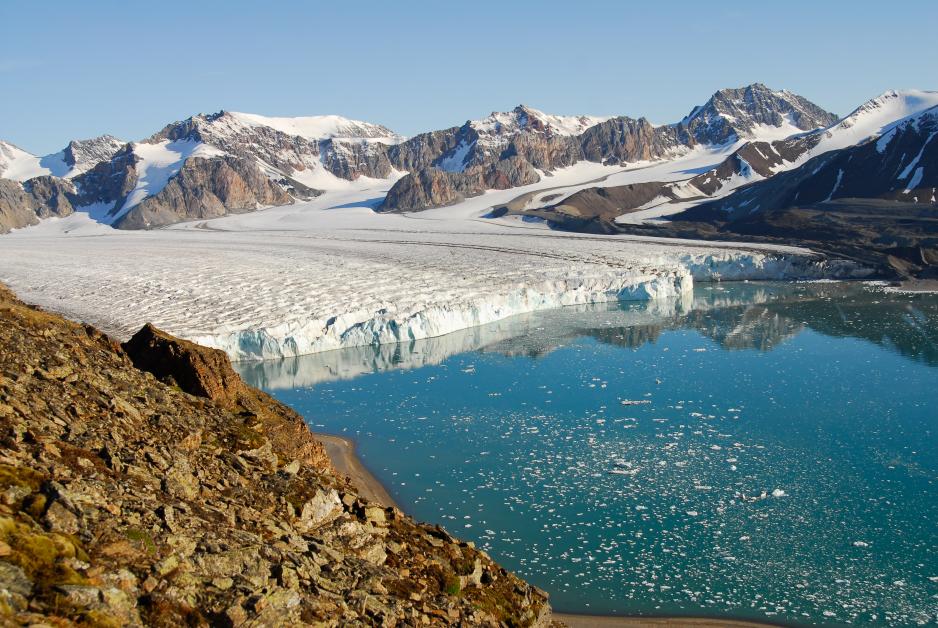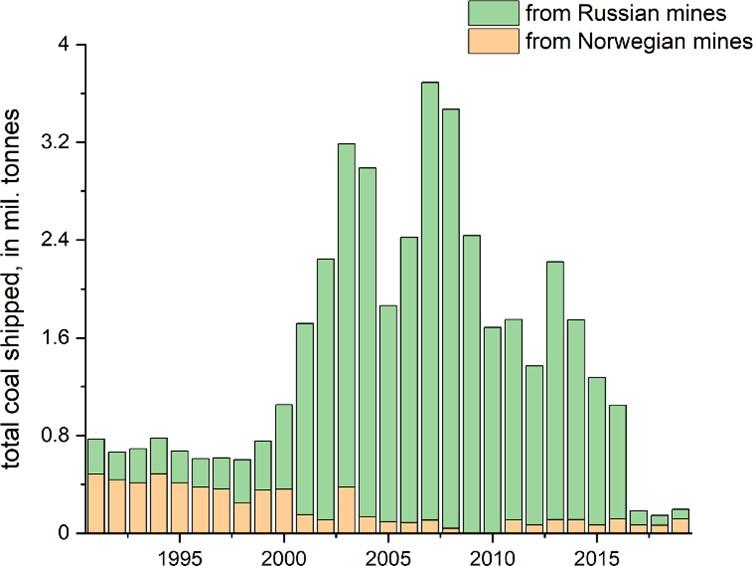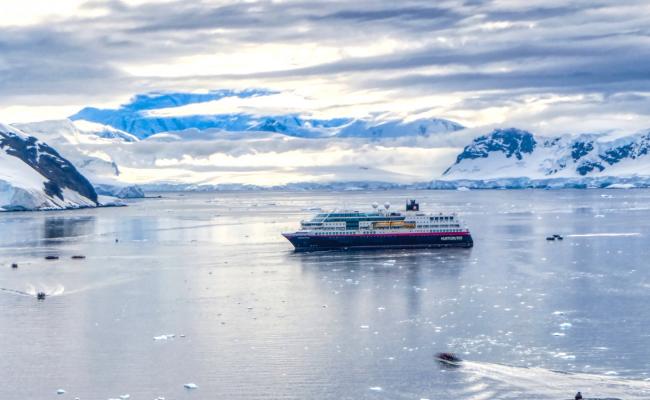Analysis: Sovereignty, Governance, and Infrastructure: Analysis of Svalbard’s White Paper 2023-2024

A marine-terminating glacier in Krossfjorden on Svalbard. (Source: GRID Arendal under CC BY-NC-SA 2.0 DEED)
This is an opinion written by an external contributor. The article expresses the writer's opinions. High North News is not responsible for the content of external links.
The White Paper on Svalbard (2023-2024) was released on May 31, 2024, providing a comprehensive overview of the policies and objectives of the Norwegian Ministry of Justice and Public Security, as well as the international legal framework governing the region. The latest document with 92 pages is shorter than the White Paper (2015-2016) totalling 119 pages.
Although the structure and logic of the policy paper remain unchanged, the new document focuses more on sovereignty, governance, and infrastructure. The new document specifically addresses the increasing economic activity on Svalbard and pressures of climate change.
Climate change
Svalbard is exposed to long-range pollution from environmental toxins carried by the air and sea currents. Despite decreasing levels in some areas, these pollutants remain alarmingly high in polar bears, Arctic gulls, seahorses, and other local species.
Since melting of sea ice and thawing of permafrost can lead to the remobilization and evaporation of pollutants into the atmosphere in the Arctic region, according to the policy it is crucial to limit the impact of local activities in Svalbard to preserve the distinctive wilderness nature of the region
Climate change is strongly present in the policy text. Climate change significantly impacts Svalbard, alters ecosystems, and threatens biodiversity. Many species are affected by diseases, parasites, pollution, and marine litter. A total of 67 alien species have been registered on Svalbard, and an action plan against invasive species has been developed, with the Governor of Svalbard responsible for its implementation.
Highlights the importance of maintaining consistent and firm enforcement of sovereignty in Svalbard
The Norwegian Polar Institute has also been tasked with updating knowledge on alien species in Svalbard to assess the need for further measures. Moreover, the Governor of Svalbard has been tasked with creating a comprehensive strategy for managing harvestable species by 2024, alongside revising current harvesting regulations.
Sovereignty
While building on the premises of the Svalbard Treaty (1920), the policy report highlights the importance of maintaining consistent and firm enforcement of sovereignty in Svalbard. Norway possesses the exclusive authority to govern all individuals and businesses, both Norwegian and foreign, within its territory. No other nation is allowed to exercise public power on Svalbard, as this would infringe upon Norwegian sovereignty
The report discusses the increased geopolitical tension in the region and the necessity of powerful measures to safeguard national security, which includes reinforcing national control over Svalbard. This includes continuing to implement and develop person control and movement control in Svalbard, based on experience gained since the introduction in 2022.
Preserving peace and stability is a key goal of the Svalbard Policy, which is deeply tied to national interests. One instrument for exercising Norwegian sovereignty is land ownership, with the government owning 98.75% of the land, including all of Longyearbyen, managed by the Ministry of Trade and Fisheries' Svalbard Office. Trust Arktikugol and AS Kulspids own 0.4% and 0.1% of the land, respectively. The state also owns 0.75% of the land through its ownership in Kings Bay AS and Bjørnøen AS.
Since 2020, the Ministry of Trade and Fisheries has managed the state-owned land on Svalbard directly, including the areas within the Longyearbyen spatial planning area.

Figure 1: Total coal shipped in mil. tonnes, Svalbard, (1991-2019) (Source: Middleton, A. (2023). Norwegian and Russian settlements on Svalbard: An analysis of demographic and socio-economic trends. Polar Record, 59, e14.)
Changing economy
Svalbard's long history as a coal mining community has come to an end, with coal production sharply declining over the past three decades. Russian coal production, once dominant in the 1990s, plummeted after the collapse of the Soviet Union, leaving Norwegian mines to produce nearly 90% of coal in the 2000s. Since 2016, both Norwegian and Russian coal production have fallen below 0.1 million tonnes annually.
The state-owned Store Norske, facing falling coal prices and negative revenue, reduced its workforce significantly and shifted its focus to diversified operations, including real estate and tourism. The last active mine, Mine 7, is expected to close by 2025.
Svalbard's employment landscape in Norwegian settlements has shifted significantly from mining to a more diverse economy. By 2021, mining jobs have drastically declined, and accommodation, catering, and public administration have emerged as major employment sectors. During 2009-20121 there was notable growth in real estate, scientific research, and the arts, indicating a strategic pivot towards broader economic activities.
According to White paper (2023-2024) the surge in tourism from 2012 to 2019, especially the rise in expedition cruise tourism, posed challenges to environmental goals and regulations. In response, amendments to the Svalbard Environment Protection Act were adopted to reduce the disturbance from human activity on wildlife and ensure efficient decision making. New rules, effective from 2025, aim to manage the environmental impact of tourism better.
Tourism in Svalbard is set to shift from focusing on growth in visitor numbers to emphasizing value creation, according to the revised 2022 "Masterplan Svalbard" by Visit Svalbard. This strategy prioritizes quality offerings that attract the right guests at the right time and place, pivoting towards sustainability to benefit the community, and ensuring the industry's long-term viability.
Also read (the text continues)
Demographic considerations
Norwegian settlements in Svalbard have seen significant growth, with the population in Longyearbyen increasing from 1,125 in 1990 to just under 2,600 in 2024. The increase in population in Norwegian settlements on Svalbard occurred due to foreign residents during last 15 years. While the number of residents from mainland Norway remained the same, the population of residents from abroad grew by 196% from 2009 to 2024.
The demographic landscape has also shifted, with foreign nationals now constituting approximately 930 (36%) of the inhabitants, representing over 50 countries. This shift reflects the diverse employment sectors in Svalbard, including research, teaching, and tourism, which attract a broad range of nationalities.
This policy reiterates similar message as the previous one, namely “The rule that Longyearbyen should not be a lifelong community is firmly established, and it is also not desirable that the community should grow beyond the current level.”
The government is concerned about the decreasing average length of stay among Norwegians, which has dropped to 3.4 years as of January 2024, a reduction of over 20% since the previous report was presented. This trend, partly due to the downsizing of mining and increased living costs, contrasts with the longer median residence times of other nationalities, particularly Thais, who averaged over ten years. The government’s goal is to encourage more Norwegians to reside in Longyearbyen.
This includes introducing incentives to attract Norwegian families with children.
Advised to familiarize themselves with the organization of public services
The government’s policy of attracting families to Longyearbyen may face challenges due to the existing state of services and infrastructure. While the government aims to attract more families to Longyearbyen, it acknowledges the limited provision of day care services. Additionally, it underscores the importance of not expanding infrastructure beyond current levels, as exemplified by the housing stock remaining unchanged since the landslides in 2015 and 2017.
Parents are advised to familiarize themselves with the organization of public services on Svalbard before they choose to stay there, considering the limited public service offer, which “may not always be in the child's best interest.” The government will consider changing the criteria for registration in the population register on Svalbard, focusing on documented residence in approved housing to attract “Norwegian workers and families.”
Moreover, housing management is considered a central tool for managing the future of Longyearbyen, with the state owning a significant proportion of the housing stock to ensure quality and attractive living conditions for Norwegian workers and families. To gain insights into demographic challenges, the government is considering a survey on living conditions in Longyearbyen.
The policy paper mentions a significant change in local democracy on Svalbard. Specifically, new regulations enacted in 2022 state that non-Norwegian citizens are only eligible to vote in the Longyearbyen local council elections if they have been registered as residents in a Norwegian municipality for at least three years before their registration in Svalbard.
This policy distinguishes between residents with ties to mainland Norway and those arriving directly from abroad, ensuring that voters have a substantial connection to Norway. In the 2023 municipal council elections, out of a population of 2596 residents in Norwegian settlements, only 1,420 were eligible to vote, with 808 actually casting their votes.

Figure 2: Employment by industry in Norwegian settlements on Svalbard, 2008 and 2021. (Source: Middleton, A. (2023). Norwegian and Russian settlements on Svalbard: An analysis of demographic and socio-economic trends. Polar Record, 59, e14)
Energy supply and infrastructure
The power supply in Longyearbyen underwent a significant shift from coal-fired plants to diesel generators by October 2023, with coal previously sourced from Mine 7. This transition led to increased production costs. Renewable energy integration is now prioritized, with plans to phase it rapidly. The government, through Store Norske, is conducting a concept selection study to explore future energy options and assess existing infrastructure conditions.
The transition to renewable energy is urgent, considering diesel generators’ environmental impact and the need to reduce costs in the long term. Efforts are underway to determine the best approach for future energy supply in Longyearbyen, while addressing maintenance backlogs and infrastructure needs.
As it stands, it is difficult to assess the environmental impact of the transition from coal to diesel generators. Statistics Norway, the national statistical agency, no longer publishes greenhouse gas (GHG) emission data specific to Svalbard due to quality concerns. The most recent data available is from 2007.
The environmental impact of transitioning from coal to diesel generators requires a comprehensive assessment, including both local air quality changes and upstream Scope 3 emissions associated with the fuel life cycle.
The fiber cable between Svalbard and the mainland, operational since 2004, faced challenges in the winter of 2022 when one of the two cables failed. Although it has been repaired and is now operational, this incident highlights the vulnerability of communication connections. Measures have been taken to enhance the resilience of the existing fiber connection, and efforts are ongoing to find a new solution for a secure and robust communication link with good capacity to Svalbard.
Research activities under control
Citizens of Svalbard treaty parties do not have an automatic right to conduct research activities on the archipelago. Since the 1960s, Norwegian authorities have actively facilitated international polar research on Svalbard, including the development of Ny-Ålesund as a research platform. Research activities on Svalbard must comply with relevant Norwegian legislation, including the Svalbard Environment Act.
Also read (the text continues)
In the policy paper, the government outlines the main principles governing research on Svalbard, based on previously established strategies. Additionally, the government will tighten research management on Svalbard by establishing a Svalbard research office led by the Research Council and Norwegian Polar Institute, enhancing both support for research and national oversight of research activities.
Research on Svalbard contributes significantly to the overall research landscape, but it also affects the fragile nature and wildlife of Svalbard. Therefore, research activities will continue to be primarily based on established local communities and research stations, with no expectation of new permanent research infrastructure outside the designated planning areas.
Points to consider
The increased granularity and new topics in Svalbard’s White Paper (2023-2024) suggest a shift towards addressing more contemporary issues such as climate change, legislative needs, and infrastructure specifics. The government considers that accounting, bookkeeping, and auditing obligations in Svalbard should be regulated more clearly and is going to prioritize work on this. While the document itself is light on geopolitical issues, actions and language assert stronger sovereignty over Svalbard.
Moreover, it is important to note that the document may not fully address the needs of multicultural communities on Svalbard, indicating a potential area for further consideration and inclusivity. It is worth examining underlying demographic trends and future population projections. Recognizing the diverse needs and contributions of residents, including both Norwegians and foreign nationals, is crucial for the sustainable development and well-being of the archipelago.
Ultimately, it is people who shape the character and spirit of this Arctic place.





